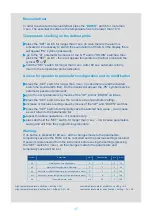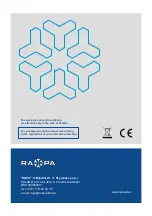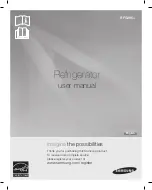
18
Description of the main signals and alarms
LED flashing
–
The activation of the corresponding function is delayed by a timer
awaiting an external signal or disabled by another procedure that is
already in progress. e.g. if is a continuous cycle in progress and a defrost is called,
the latter will remain pending until the end of the continuous cycle, and the
corresponding LED (defrost) will flash.
OFF flashing
– state of the controller - OFF, to return to working mode (ON)
press and hold ON/OFF button for more than 3 sec.
E0 steady
– control probe error (1) – active sound signal:
probe not working: the probe signal is interrupted or short-circuited;
probe not compatible with the instrument.
The E0 alarm signal is constant when it is the only active alarm (the temperature
value is not displayed).
E0 flashing
– control probe error (1) – the alarm signal E0 is steady if it is the only
active alarm (the temperature value is not displayed), while it flashes if other alarms
are active or the second probe is displayed.
E1 flashing
– evaporator probe error (2):
probe not working, the probe signal is interrupted or short-circuited;
probe not compatible with the instrument.
Ed flashing
– The last defrost ended after exceeding the maximum duration rather
than when reaching the end defrost set point. The message disappears when the
next defrost ends correctly.
EF displayed during operation or on power-up
– operating parameter reading
error (controller automatic reset). Alarm reappearance after automatic reset
– it is
necessary to check the controller as there is no guarantee to keep the original
precision of the operation.
EE
–
data errors
– In certain operating conditions, the instrument may detect errors
in the data saved. These errors may compromise the correct operation of the
instrument. If the microprocessor detects a data saving error, the display shows the
message
“EE”.
If the fault persists, the controller needs to be replaced. If, on the
other hand, the message disappears, it can continue to be used. When
“EE”
error
occurs frequently and/or remains for some time, the controller should be checked,
as the original precision may not be guaranteed.
LO flashing
–
low temperature alarm. The probe has measured a temperature
lower than the set point by a value that exceeds parameter AL:
check parameters AL, Ad and A0.
The alarm is automatically reset when the temperature returns within the set limits
(see parameter AL).
HI flashing
– high temperature alarm. The probe has measured a temperature
higher than the set point by a value that exceeds parameter AH.
check parameters AH, Ad and A0.



































